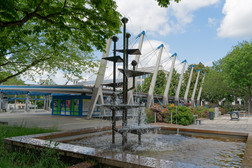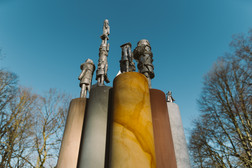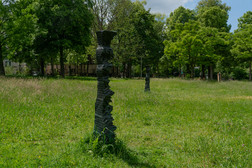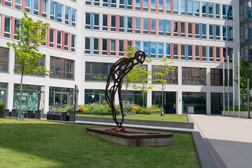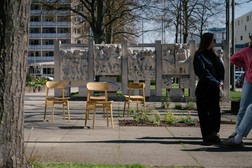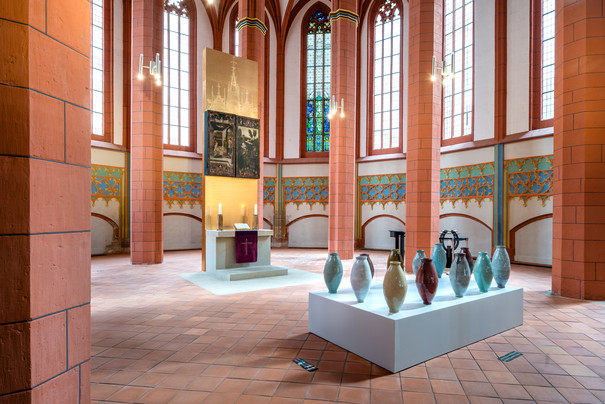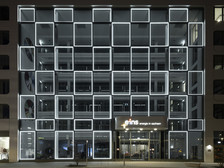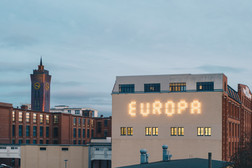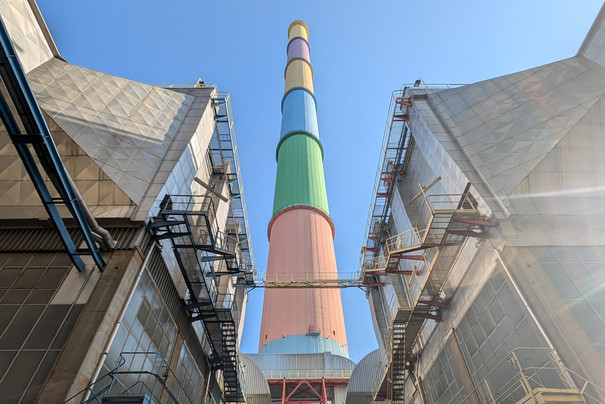Between the industrial charm and standardised romanticism of prefabricated buildings, you can discover impressive sculptures, luminous installations on building facades and bronze contemporary witnesses in Chemnitz. The works of art in public spaces tell stories of new beginnings and community, but also take a look into the past.
We have put together a route for the PURPLE PATH artworks in Chemnitz that you can easily explore during your stay. Not only will you learn more about the history of the city, but also about the people who live here.
Five minutes from the railway station
A branching pipe architecture grows out of a shallow, square concrete basin, supplying small fountains with water. The rhythmically varying rattling sound that this produces gave the work of art its name: "Klapperbrunnen". The sculptor Johann Belz created it in 1967/68. Two PURPLE PATH artworks can be found opposite on Schillerplatz: Eberhard Göschel's "Cora and Mabel" and Osmar Osten's "Oben Mit".
Off to the city centre
If you follow Bahnhofsstraße towards the city centre, you will be greeted by Michael Morgner's steel sculpture "Reliquie Mensch" in front of the Technical City Hall. Stylised into striking ciphers, Morgner's human images unfold a power between rebelling and sinking, the fateful being thrown into the world and the urge to escape from it. A few minutes' walk away on Brückenstraße in Chemnitz is the intervention "Seeds & Seats" created by Gabriela Oberkofler & Jacob Strobel. The ensemble of wooden chairs, based on a GDR design classic, is labelled with text fragments by Bertolt Brecht and thematically ties in with the monuments to praise poetry that have stood at this location for over 50 years. Visitors are invited to freely arrange the chairs and create their own "sitting poems".
Stopover in the church
The town church of St. Jakobi is located in the city centre, directly behind the historic town hall. Glazed vases in different colours are arranged in front of the altar, the work of South Korean ceramic artist Young-Jae Lee. Lee's work centres on vessels and large-format bowls, which she arranges into installations in her exhibitions, often temporarily redefining her exhibition spaces.
Let there be light
When it gets dark in Chemnitz, it's worth taking a stroll through the city centre. Andreas Schmid's "Colourfield Chemnitz" lights up at the entrance to the Chemnitz Art Collections. A light art installation consisting of 38 LED bundles, which he created to mark the 100th anniversary of the art collections. the facade of the administrative building of eins energie in sachsen GmbH & Co. KG on Johannisplatz lights up at random. The installation "Light lights" by artist Hans Peter Kuhn is responsible for this. In 2019, the lettering EUROPA by the Berlin architecture firm morePlatz was installed on the façade of the Wirkbau. As part of the successful bid to become European Capital of Culture, the artwork became a shining message for the old Saxon industrial metropolis.
Away from the centre
Saxony's tallest building is located in Chemnitz, on the site of the decommissioned Nord cogeneration plant. in 2013, French conceptual artist Daniel Buren bathed the almost 302-metre-high chimney in seven bright colours: the result is "7 Colours for a Chimney", probably the tallest work of art in the world. The building has long been the city's secret landmark and is affectionately known as the Lulatsch by locals. in 2017, LED lights were installed on the chimney so that it can also be seen at night. By the way: from 18 July to 17 August 2025, the Begehungen art festival will take place on the site of the combined heat and power plant.
